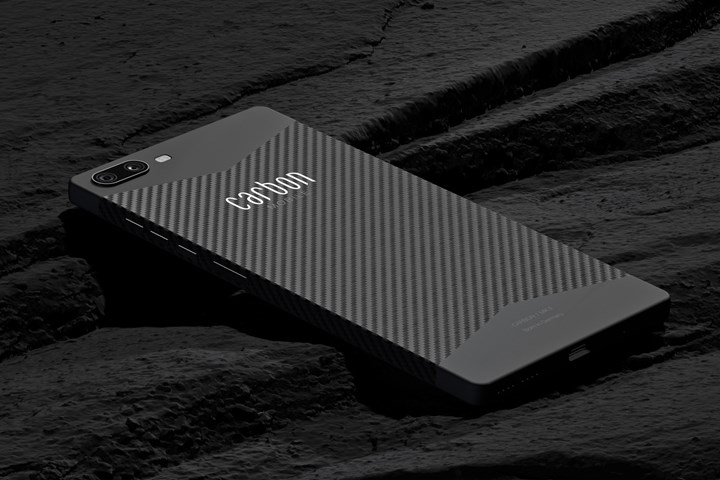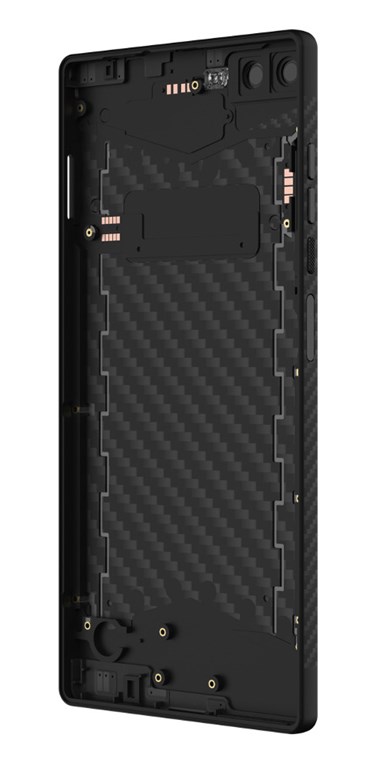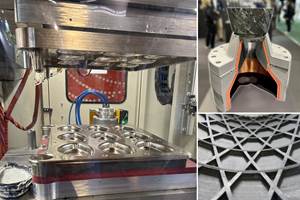Carbon Mobile carbon fiber smartphone unlocks RF signal permeation capabilities
Housing is made from Lanxess Tepex thermoplastics reinforced with 1K continuous carbon fiber using Carbon Mobile’s patented HyRECM process for a “radio-enabled” composite material.

Photo Credit: Lanxess
Lanxess (Cologne, Germany) reported on March 16 that the Carbon 1 MK II smartphone being debuted this month by startup company Carbon Mobile (Berlin, Germany) has replaced plastics and aluminum with advanced composite materials. Said to be first carbon fiber smartphone, the base material for the production of the housing is a thermoplastic composite from the Lanxess Tepex dynalite product range, and is reinforced with 1K continuous carbon fiber filaments for a light, slim design that is made 5% less plastic.
“Our composite material, which we developed for lightweight components subjected to considerable mechanical stress, does more than just allow exceptionally thin wall thicknesses. In fact, with its high degree of strength and rigidity, it also helps to make the housing very robust for day-to-day use,” explains Philipp Genders, Tepex expert in application development at Lanxess. “In addition, the matte-black carbon fibers give the smartphone a truly high-tech look.”
However, Carbon Mobile says, use of carbon fiber initially had its challenges. The company notes that, despite their advanced properties for producing robust yet lightweight structures, carbon fibers are effective against electromagnetic shielding, which means that, rather than allowing radio signals to pass through, the material disperses them around the outer body of the device. Connected devices with carbon fiber, for this reason have been viewed as a road block by the tech industry.
Nonetheless, the Carbon 1 MK II smartphone follows four years of research and development by Carbon Mobile’s engineers, which resulted in the HyRECM (Hybrid Radio Enabled Composite Material) technology, a patented process that fuses carbon fibers together with a complementary composite material capable of radio frequency (RF) signal permeation. To further boost the devices’ connectivity, a 3D-printed conductive ink is integrated into the carbon fiber structure. Carbon Mobile claims this has resulted in the first “radio-enabled” carbon fiber-based material.

Carbon 1 MK II carbon fiber monocoque. Photo Credit: Lanxess
“Lanxess and their Tepex materials made the perfect partner in the development of HyRECM Technology,” say Eric Chan from processing partner Modern Composites Ltd. (Hong Kong, China) says. “Being able to work with a superior material from Germany ensures the best application possible of this revolutionary technology from launch.”
Following the same construction principle as the load-bearing chassis of a Formula 1 car, the housing is designed as a monocoque, or “single shell” for high rigidity. Carbon Mobile says this contributes significantly to the thin wall thicknesses, light weight of the smartphone and also enables miniaturization because there is no bulky reinforcement taking up space on the inside of the housing. According to Firas Khalifeh, CEO of Carbon Mobile, “Our cutting-edge monocoque design enables a device that weighs only 125 grams, a third lighter than conventional smartphones. At just 6.3 millimeters, it is also 25% thinner as well.”
Carbon Mobile adds that it is committed to sustainable principles. The new smartphone uses only recyclable materials wherever possible. “We want to deliver our contribution to cutting electronic waste and improving sustainability around the world,” says Khalifeh.
The composite material used for the housing can also easily be recycled and repurposed for new uses. “Like all products in the Tepex dynalite product line, it can be shredded and then processed on standard injection molding machines to make high-quality components, either by itself or mixed with suitable new material,” adds Genders. To extend the service life of the smartphone, all its components are designed to be easily replaceable for repair purpose, which also prevents electronic waste.
Related Content
Development of a composite liquid hydrogen tank for commercial aircraft
Netherlands consortium advances cryogenic composites testing, tank designs and manufacturing including AFP, hybrid winding, welding of tank components and integrated SHM and H2 sensors for demonstrators in 2025.
Read MorePlant tour: Collins Aerospace, Riverside, Calif., U.S. and Almere, Netherlands
Composite Tier 1’s long history, acquisition of stamped parts pioneer Dutch Thermoplastic Components, advances roadmap for growth in thermoplastic composite parts.
Read MoreJEC World 2024 highlights: Thermoplastic composites, CMC and novel processes
CW senior technical editor Ginger Gardiner discusses some of the developments and demonstrators shown at the industry’s largest composites exhibition and conference.
Read MoreOtto Aviation launches Phantom 3500 business jet with all-composite airframe from Leonardo
Promising 60% less fuel burn and 90% less emissions using SAF, the super-laminar flow design with windowless fuselage will be built using RTM in Florida facility with certification slated for 2030.
Read MoreRead Next
Ceramic matrix composites: Faster, cheaper, higher temperature
New players proliferate, increasing CMC materials and manufacturing capacity, novel processes and automation to meet demand for higher part volumes and performance.
Read MoreCutting 100 pounds, certification time for the X-59 nose cone
Swift Engineering used HyperX software to remove 100 pounds from 38-foot graphite/epoxy cored nose cone for X-59 supersonic aircraft.
Read MoreNext-gen fan blades: Hybrid twin RTM, printed sensors, laser shock disassembly
MORPHO project demonstrates blade with 20% faster RTM cure cycle, uses AI-based monitoring for improved maintenance/life cycle management and proves laser shock disassembly for recycling.
Read More












